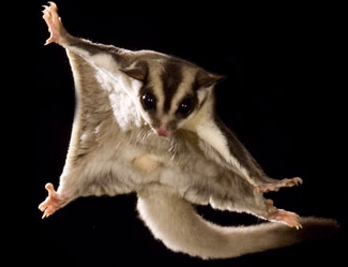
This is the second time around that we have featured the sugar glider as our Animal of the Month. But now that September is drawing to a close, it means we have to once again say “until next time” to these unusual little pocket pets. We hope you enjoyed following us on Twitter @ExoticPetVets as we tweeted all month about sugar gliders. But we are offering you a summary in case you missed any of our tweets. Did you know?:
- Sugar gliders (Petaurus breviceps) are small mammals native to Australia, Indonesia and Papua New Guinea. They are also found in Tasmania, but were introduced to the island in the 1800’s.
- Sugar gliders are also commonly known as sugar bears or honey gliders.
- They may look like they’re rodents, but sugar gliders are actually marsupials like kangaroos and koalas. A distinct characteristic of marsupials is that the females carry their babies in abdominal pouches.
- Breeding season for sugar gliders is typically winter and spring. Sugar glider pregnancy is very short, lasting only about 15-17 days. Female sugar gliders usually give birth to two babies at a time.
- When they are born, sugar gliders are as tiny as a pea or a grain of rice. They crawl into their mother’s pouch and will stay there until they are just over two months old.
- Sugar gliders are small. Fully grown, their body length measures 5-7 inches (about 16 cms), with another 5-7 inches of tail length. They can weigh between 80-160 grams.
- Sugar gliders have soft short grey fur with cream-coloured fur on their bellies. They have a black stripe running from just above the nose and down the length of their backs, ending just before their tails.
- Sugar gliders are sexually dimorphic, meaning you can tell the difference between males and females. Males are a bit larger and heavier than females. The characteristic stripe tends to be thinner on females.
- Sugar gliders have five digits on all four of their feet. Both of their hind feet have opposable toes, which helps them grip branches.
- The most distinctive characteristic of sugar gliders is – obviously – their ability to glide through the air.
- Sugar gliders have a patagium, which is a fold of skin or membrane that is attached to their front and rear ankles.
- When sugar gliders extend their legs, the patagium stretches out to form a built-in parachute that allows them to glide from tree to tree.
- The sugar glider’s ability to glide is a unique defense mechanism that allows her to avoid predators, which include cats, foxes, monitor lizards, kookaburras and owls.
- Sugar glider tails are long and flat and are considered to be semi-prehensile, which means they can carry light objects with their tails, but they can’t hang from them.
- Sugar glider tails are also used as rudders to give them balance and help them steer while they are gliding.
- Sugar gliders are very social animals and in the wild will live in groups of 6-10 along with their offspring in one nest.
- Because they are so social, sugar gliders in captivity need daily attention and should not be kept alone as this can lead to depression.
- Properly socialized sugar gliders in captivity will also become very attached to their human family members and enjoy riding around in people’s pockets.
- Wild sugar gliders only live around five years on average. But with proper care, captive sugar gliders can reach a 15-year lifespan.
As mentioned above, this is the second time we have featured sugar gliders as our Animal of the Month. Check out our blog post from December 2015 to see our tweets about sugar gliders the first time around!

